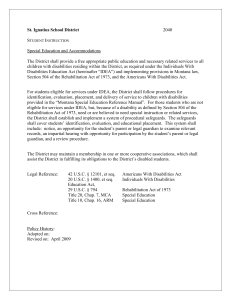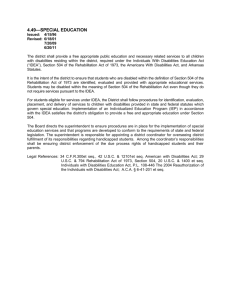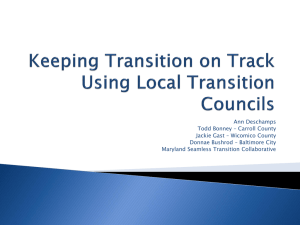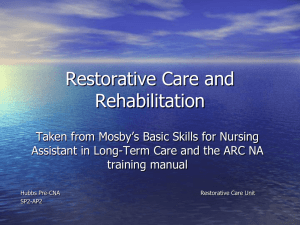outcomes
advertisement
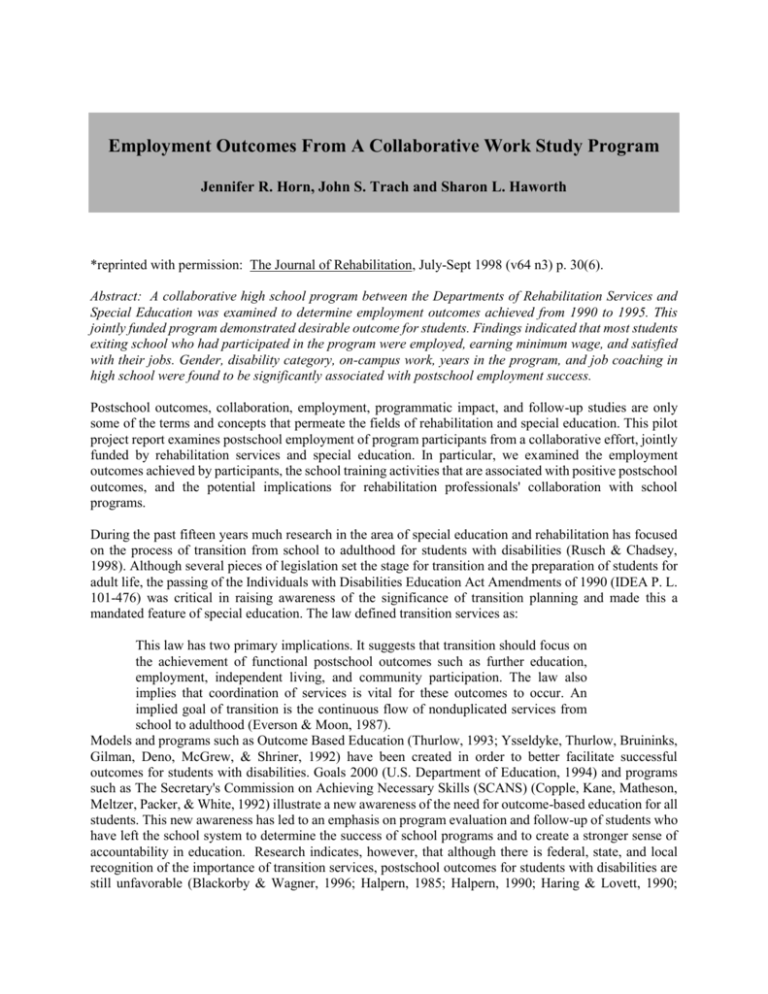
Employment Outcomes From A Collaborative Work Study Program Jennifer R. Horn, John S. Trach and Sharon L. Haworth *reprinted with permission: The Journal of Rehabilitation, July-Sept 1998 (v64 n3) p. 30(6). Abstract: A collaborative high school program between the Departments of Rehabilitation Services and Special Education was examined to determine employment outcomes achieved from 1990 to 1995. This jointly funded program demonstrated desirable outcome for students. Findings indicated that most students exiting school who had participated in the program were employed, earning minimum wage, and satisfied with their jobs. Gender, disability category, on-campus work, years in the program, and job coaching in high school were found to be significantly associated with postschool employment success. Postschool outcomes, collaboration, employment, programmatic impact, and follow-up studies are only some of the terms and concepts that permeate the fields of rehabilitation and special education. This pilot project report examines postschool employment of program participants from a collaborative effort, jointly funded by rehabilitation services and special education. In particular, we examined the employment outcomes achieved by participants, the school training activities that are associated with positive postschool outcomes, and the potential implications for rehabilitation professionals' collaboration with school programs. During the past fifteen years much research in the area of special education and rehabilitation has focused on the process of transition from school to adulthood for students with disabilities (Rusch & Chadsey, 1998). Although several pieces of legislation set the stage for transition and the preparation of students for adult life, the passing of the Individuals with Disabilities Education Act Amendments of 1990 (IDEA P. L. 101-476) was critical in raising awareness of the significance of transition planning and made this a mandated feature of special education. The law defined transition services as: This law has two primary implications. It suggests that transition should focus on the achievement of functional postschool outcomes such as further education, employment, independent living, and community participation. The law also implies that coordination of services is vital for these outcomes to occur. An implied goal of transition is the continuous flow of nonduplicated services from school to adulthood (Everson & Moon, 1987). Models and programs such as Outcome Based Education (Thurlow, 1993; Ysseldyke, Thurlow, Bruininks, Gilman, Deno, McGrew, & Shriner, 1992) have been created in order to better facilitate successful outcomes for students with disabilities. Goals 2000 (U.S. Department of Education, 1994) and programs such as The Secretary's Commission on Achieving Necessary Skills (SCANS) (Copple, Kane, Matheson, Meltzer, Packer, & White, 1992) illustrate a new awareness of the need for outcome-based education for all students. This new awareness has led to an emphasis on program evaluation and follow-up of students who have left the school system to determine the success of school programs and to create a stronger sense of accountability in education. Research indicates, however, that although there is federal, state, and local recognition of the importance of transition services, postschool outcomes for students with disabilities are still unfavorable (Blackorby & Wagner, 1996; Halpern, 1985; Halpern, 1990; Haring & Lovett, 1990; Hasazi, Gordon, & Roe, 1985; Marder & D'Amico 1992; Mithaug, Horiuchi, & Fanning, 1985; Wehman, Kregel, & Seyfarth, 1985). Also adult services, especially vocational rehabilitation services, have little involvement in assisting transition-aged youth in finding and keeping a job (DeStefano & Wagner, 1993). Students with disabilities are not achieving success in areas of adult life such as employment, independent living, and community participation (Blackorby & Wagner, 1996; Halpern, 1995; Halpern, 1990; Hating & Lovett, 1990). Although many factors contribute to this phenomenon, the lack of continuity of services from school to work is certainly one important factor (Halpern, 1985; Will, 1984). One way of ameliorating this problem is to create high school programs that require collaboration between special education and rehabilitation services in order to facilitate a more effective transition. This study examined the relationship between students, programmatic characteristics, and postschool employment outcomes from a collaborative high school work study program. METHODS Description of Program The Secondary Transitional Experience Program (STEP) is a work cooperative program funded, in part, by the Department of Rehabilitation Services (DORS) and administered by the schools. Students are eligible for the program if they have a disability, are receiving special education services, and meet DORS eligibility requirements. STEP is designed to provide work experience in order to promote future independence in the areas of employment, residential life, social integration, and community participation for students with disabilities. The program stresses individualized, coordinated vocational planning and "integrated, paid, unsubsidized community employment" (Illinois Department of Rehabilitation Services, 1991, p. 5). Program descriptions state that vocational planning is individualized; that transition, IEP, and IWRP plans are coordinated; and that the STEP programs are an integral part of the educational curriculum which results in integrated, paid, unsubsidized community employment for student participants. The STEP contractor is responsible for providing school services and accessing all financial resources available. DORS is responsible for assigning a rehabilitation counselor to perform such duties as taking applications; determining eligibility; meeting with parents, students, and school personnel; developing the IWRP; and assisting with the IEP. Each student receives two to three hours of services each day unless prohibited by his/her disability. The contractor is paid for the placements of students with severe disabilities (i.e., two or more functional limitations) who work at least 120 days for at least two hours per day. Participants The participants in this study (N=18) were a sample of individuals who had exited high school from a suburban, midwestern school district between the years of 1990 and 1995. The sample group consisted of those students who could be located and agreed to participate. One student exited in 1990, 2 in 1991, 2 in 1992, 3 in 1993, 6 in 1994, and 4 students exited in 1995. Eighteen students were interviewed from an original sample of 47 students, all of whom had participated in the STEP program (38.3% participation rate). Twenty-five exiters (i.e., those students who graduated, dropped out, or otherwise ended school participation) were contacted; 7 chose not to participate, while 18 agreed to be interviewed. Ten females and 8 males, ranging in age from 20.6 to 26.5 years of age at the time of the interview (mean age = 23.3), participated in the study. These students were labeled by the schools as Trainable Mentally Disabled (TMD) (4 or 22.2%), Educable Mentally Disabled (EMD) (10 or 55.6%), Learning Disabled (LD) (2 or 11.1%), and Behaviorally/Emotionally Disabled (BD/ED) (2 or 11.1%). Students exited high school by either graduating, dropping out, or reaching 21 years of age and therefore aging out. Fifteen of the former students (83.3%) were in self-contained classrooms during high school, while only 3 students (16.7%) received school services in resource rooms. While all of the students participated in the STEP program, their years in the program ranged from 1 to 5 with a mean of 2.22 years and a standard deviation of 1.06. Two of the students interviewed were African-American (11.1%), 1 student was Asian (5.6%), and 15 were Caucasian (83.3%). Survey Instrument The survey instrument consisted of high school background/ demographic sheet and a questionnaire comprised of yes-no, multiple-choice, and open-ended questions. The instrument was created to address the postschool outcomes of employment, postsecondary education, independent living, and community participation. For the purpose of this study, specific employment outcomes were the focus. The survey also included questions regarding types of classes taken, participation in IEP meetings, knowledge of adult services, and students' perception of the effectiveness of high school and the amount of control they had in determining their futures. The instrument was used to conduct a one hour face-to-face or phone interview with each participant. Fifteen interviews were conducted in person and three interviews were conducted over the phone. Face-to-face interviews were conducted to increase survey return, to ensure that former students were the actual respondents, and to ensure that participants understood the questions. Phone interviews were only conducted in the case where an exiter was unavailable to meet in person, did not wish to meet, or was in an inaccessible location. A portion of the interviews were recorded and checked for reliability. Although the former student was always the primary provider of information, in some situations the parent or guardian was present and assisted with providing information. One individual used a communication device along with limited signing, resulting in some missing data. Another individual with limited communication agreed to participate, but then became disinterested before the interview was completed. One other former student who was interviewed by phone agreed to answer questions within the employment section and several questions from other sections, but did not complete the entire survey. Interviewers Two graduate research assistants performed the data collection. The interviewers prepared for the interviews by conducting the survey with one another and conducting a pilot with eight students who were currently enrolled in the STEP program. A reliability check was performed by a third graduate research assistant, trained by the principal author, by listening to tape recorded interviews and scoring the survey. Procedure Lists of possible participants included the names, phone numbers, and addresses of all of the students who left this high school district between 1990 and 1995 and had participated in the STEP program. Individuals were contacted by phone to determine their willingness to participate. If they agreed to participate, a meeting was arranged to conduct the survey at either their former high school, the local Department of Rehabilitation Services, the individual's home, a local restaurant, or over the phone. A consent form was read to and provided for all interviewees. In cases where the individual had a legal guardian, both the respondent and the guardian read (or were read) the consent form and gave permission. The interviews were conducted by reading the questions and recording the participants' responses. Participants were provided with a copy of the survey if they wished to follow along. Validity In order to address content validity, the instrument was developed from pre-existing instruments that had been used to perform similar follow-up studies (Menchetti, English, Burkhead, Leach, & Johnson, 1991; State of Florida Department of Education, 1988; Hull, 1990; "Year After", n.d.). In addition, STEP counselors and school vocational counselors (secondary special education teachers responsible for career development and placement) were interviewed to determine which questions should be included in a follow-up survey of this nature. The survey was piloted with 8 current STEP students and revised accordingly. It was then submitted to the local Rehabilitation Services Supervisor and to the Director of Special Education for their critique and approval. The instrument also incorporated a mechanism to prevent the internal validity threat of acquiescence bias, which is the tendency for an individual to agree or respond positively without regard to the question asked (Heal & Sigelman, 1994). Six pairs of questions were used to assess acquiescence bias. Each pair of questions asked for the same information, but were phrased in such a manner that a respondent would have to answer "yes" to one question and "no" to the other question in order to provide the same information (i.e., provide consistent or corroborative responses). A "yes" response was given a score of +1, a "no" was given a score of -1, and "I don't know" was assigned a score of 0. These scores were then added for all six pairs. A score of 0 would reflect an accurate response to all questions (i.e., positive and negative 1 would equal 0). If a respondent had a total score of +6 it would indicate that he or she answered 50% of the questions positively (e.g., 6 pairs of questions all answered yes would equal 12), suggesting a tendency to acquiesce without regard to the content of the question. Likewise, if a respondent had a score of -6 (e.g., 6 pairs of questions all answered no would equal -12), that individual may have had a tendency to say no regardless of the meaning of the question (Dwyre, 1995). Reliability Seven interviews (38.89%) were tape-recorded and tested for reliability. All of the objective questions and the 12 questions concerning employment history (i.e., type of job, length of job, and reason for leaving last four jobs) were included in the reliability check. The graduate assistant checking reliability listened to the audio tape of the entire interview and completed a blank survey based on the respondent's answers. Reliability was then calculated by computing the number of agreements over the total number of agreements and disagreements. Total reliability was calculated as 88.35%, ranging from 81.32% to 92%. Consensus was then reached on questions in which disagreement occurred by reviewing the responses and mutually deciding on what the correct response would be. Analysis Four types of analysis were used in order to address the research questions. Descriptive statistics were used to report the general employment outcomes for individuals who participated in the Secondary Transitional Experience Program. Chi-square tests of association and analysis of variance were utilized to determine the relationship between personal and programmatic characteristics and employment outcomes. Finally, linear regression was used to calculate relationships between high school experience and wages earned after high school. RESULTS Acquiescence As explained in the Methods section, six pairs of questions were incorporated within the survey instrument to determine whether the respondents had a tendency to answer "yes" or "no" without regard to the content of the question. Results indicated that none of the respondents had scores that exceeded positive or negative 3, suggesting that none of the interviews were affected by acquiescence bias (i.e., the tendency for an individual to agree or respond positively without regard to the question asked) (Dwyre, 1995). General Employment Outcomes Fourteen of 18 exiters reported that they were working in competitive, paid employment at the time of the interview (77.8%). Four respondents were not employed at the time of the study. Seventeen exiters reported having been employed at some point since they left high school in the areas of food service, janitorial/maintenance, clerical, light industrial, service, construction, agriculture, and other. One exiter was currently working in a sheltered workshop/day activity center and one, who had previously worked in a sheltered setting, had a volunteer position doing laundry for a nearby household. Summary of General Employment Outcomes for Students Participating in a Collaborative Work Study Program (N= 18): Employment Status Hours Worked per Week Job Status Job Tenure Salary 14/18 working Range = 4 to 55.5 88.9% satisfied x = 2.53 jobs since H.S. Range=$0.00 to $23.00 Employment Status Hours Worked per Week Job Status Job Tenure Salary 17/18 worked since H.S. x = 27 38.9% want more hours 48% quit (reason for leaving) x = $4.98 (without outliers) The hours per week that former students worked varied from 4 to 55.5, with a mean of 27 hours. Most of the individuals (88.9%) reported that they like their current or most recent job, though 38.9% indicated that they would like to work more hours per week. The respondents had an average of 2.53 jobs after exiting high school, and their most common reason for leaving a job was quitting (48%). Respondents' salaries ranged from $0.00 to $23.00 per hour (m=$5.48) (SD = 5.015, median = $4.87, and mode = $5.50). Excluding those that did not make any money per hour and the $23.00 per hour, the average wage per hour was $4.98 (N = 13). Employment Outcomes and High School Experience Chi-square analysis revealed that current employment status was significantly related to on-campus work while in high school (x2 = 4.114, df = 1, p = .043). Those individuals who worked on-campus were less likely to be employed after leaving high school. Chi-square analysis also revealed that employment was not significantly related to disability category (x2 = 4.114, df = 3, p = 249), gender (x2= .064, df = 1, p = .800), perception of high school experience (x2 = .486, df = 1, p = .486), or whether students were in a self-contained class (x2 = .25714, df = 1, p = .61209). Similarly, current employment was not related to year of exit (x2 = 4.982, df = 5, p = .418), work incentives during high school work experience (x2 = 2.822, df = 1, p = .093), or job coaching during high school work experience (x2 = .643, df = 1, p = .423). In addition, analysis of variance revealed no relationship between years in STEP and current employment status (F = 1.240, df = 2, 15, 17, p = .317). Wages and High School Experience Linear regression revealed that hourly wages were significantly related to disability category (R = .853, r2 = .727, F = 6.668, p = .007, B = .727). When 1 outlier was removed from the Behavior and Emotional Disabilities (BD/ED) category (the individual who earned an average of $23.00 per hour) this variable accounted for 61.8% of the variance and regression revealed that Educable Mental Disabilities (EMD) and Learning Disabilities (LD) labels were associated with higher wages than other disability categories (R = .853, r2 = .727, F = 6.668, p = .003, B = 3.032, p = .029, B = 2.732, respectively). Results also indicated that (a) males earned more than females (R = .853, r2 = .727, F = 6.668, p = .015, B = -1.860); (b) the number of years an individual was involved in the STEP program was negatively correlated with wages earned after exiting high school (R = .712, r2 = .507, F = 1.469, p = .013, B = -3.853); and (c) receiving job coaching while in high school correlated negatively with the amount of money earned after exiting high school (R = .839, r2 = .704, F = 8.725, p = .014, B = -1.966). Discussion Results from this study indicate that the exiters interviewed have a higher employment rate than exiters with disabilities from previous studies. For example, almost 78% of STEP exiters were employed as compared to 57.6% (Blackorby & Wagner, 1996), 43% (Hasazi, Gordon, Roe, Finck, Hull, & Salembier, 1985), and 12% (Wehman et al., 1985) of similar groups. In addition, the employment rate for exiters of STEP is also higher than the employment rate reported for individuals without disabilities (69%) (Blackorby & Wagner, 1996). These numbers could be the result of a sampling bias because the exiters who were interviewed may have been easier to find due to their jobs and contact with DORS; they may also indicate that employment outcomes for individuals with disabilities are improving. Findings from this study indicated a relationship between employment status and on-campus work during high school. Students who worked on-campus during high school were less likely to be employed after high school. These findings are somewhat similar to those of Hasazi, Gordon, Roe, Finck, et al. (1985). Although they did not find a significant difference in employment status for those who participated in a work experience program versus those who did not, they did find that "higher present wages were associated with having one or more vocational classes in high school and with having held a part-time outside job during high school" (p. 228). Perhaps on-campus work is not a close enough approximation of "real" work and therefore impedes later employment. Another possibility is mat these results might reflect the expectations of the program due to other factors (e.g., severity of disability). In other words, those persons with more severe disabilities were not viewed as having employment potential, were considered less likely to be hired by employers, and were placed in a "safe" environment without the stresses of normal employment settings. Several findings of interest concerning hourly wages were also suggested by the data. Although wages seemed to be significantly related to disability category (EMD and LD; p=.007), it is important to note that individuals from these two categories make up the majority of the sample and may have skewed the results. In addition, males earned more money than females after high school, which is consistent with the current situation in the general population. Blackorby and Wagner (1996) found that 44.3% of males and only 23.0% of females made more than $6.00 per hour. They also noted that "their wages were comparable to those earned by noncollege youth of similar ages in the general population" (p. 405). Two findings of particular interest, which are more related to programmatic characteristics, were that having a job coach in high school and years spent in the STEP program seemed to be negatively correlated with wages after high school (p=.014, B=-1.966 and p=.013, B=-3.853). These findings support those of Hasazi, Gordon, Roe, Finck, et al. (1985) who reported that, "work experience participation in high school was significantly associated with lower wages..." (p. 228). Although "work experience program" is not clearly defined, they did indicate that those individuals who had work experience outside of high school, as opposed to work in a school-based work experience program, were more likely to have higher wages after high school. Once again, real work experience might be seen by future employers as evidence of work, potential, whereas school experience may be viewed simply as simulation of real work without the true test of circumstances from the work environment (e.g., consequences of errors, integration into social culture, adapting to variations in work pace due to demands). Many variables were analyzed in this study and found to be nonsignificant in their relationship to outcomes. This may be a result of the small sample size or the fact that the participants were unable to be matched based on year of exit and disability category. Although this study was limited by its sample size, it was able to provide administrators of the Secondary Transitional Experience Program with new information about how their students are faring after leaving high school. Not only did it provide information concerning outcomes, but it also allowed individuals most affected by this program to voice their opinions and perceptions. This program was of particular interest because it was a collaborative transition program involving both the Department of Special Education and the Department of Rehabilitation Services which affords early interaction between the two departments during a student's high school experience. As suggested by previous research, this interaction is one effective way of improving collaboration and therefore improving the transition process in general (Hanley-Maxwell & Szymanski, 1992). The STEP program also attempts to promote paid, integrated employment for students while they are in high school. This factor has also been suggested to be a critical variable in facilitating the fluid transition from school to work for students with disabilities (Hasazi, Gordon & Roe, 1985; Mithaug et al., 1985; Wehman et al., 1985). These results are important for at least two reasons. First, these activities indicate that school programs are emulating postschool outcomes by providing paid work experience while still in school. Next, the collaboration with postschool service agencies recognizes that public school will end and transition means transferring to some other agency for training and support. Results of this study indicate that although students from this program are working, most are working in entry-level positions, just above minimum wage, and have few benefits. It seems that collaborative programs such as STEP have much potential and could greatly affect the future outcomes of students who participate in such programs. Implications for Rehabilitation and Future Research Although it is difficult to conduct follow-up studies of this nature, it is imperative that they continue to be performed. They are the only tool to measure how effective our school and rehabilitation programs are in promoting positive postschool outcomes. The study's findings seem to suggest that rehabilitation counselors must play a more active role in this type of program and process of transition. After all, many students transitioning from schools will almost certainly engage rehabilitation services at some point in their lives. In fact, it would be prudent for rehabilitation counselors to define a specific role for themselves within the process (e.g., job development and placement). Participants interviewed for this study recognized the school's role in the work study program, but only recognized the counselor by name and not affiliation. In other words, most did not know of the Department of Rehabilitation. Funds for this program came from the rehabilitation agency, and there was some expectation that students would eventually go through the rehabilitation agency. However, the current role of the agency was not recognized or visible. Also, if we are to expect to successfully serve consumers, the connection to the agency must be explicit and more direction is needed to facilitate and maintain employment. Future research surveying students, parents, and professionals would provide added insight into the effectiveness of these programs. In addition, comparative analyses between students who are involved in various types of work-study programs within special and regular education would be useful. In order to do these types of evaluations, it is of great importance that schools and rehabilitation agencies pool their resources and information in order to locate and gather information about their students and to create new curricula that reflect the knowledge gained from these evaluations. Summary of Employment Outcome Predictors Employment Outcome Disability Category Gender Perception of High School Class Setting Exit Date Work Incentives Job Coaching On Campus Work chi-square df 4.114 .064 .486 .257 4.982 2.822 .643 4.114 3 1 1 1 5 1 1 1 p .249 .800 .486 .612 .418 .093 .423 .043(*) (*) p<.05; Caution should be used when interpreting these results due to small cell size. References Blackorby, J., & Wagner, M. (1996). Longitudinal postschool outcomes of youth with disabilities: Findings from the National Longitudinal Transition Study. Exceptional Children, 62, 399-413. Copple, C. E., Kane, M., Matheson, N. S., Meltzer, A. S., Packer, A., & White, T. G. (1992). The Secretary's Commission on Achieving Necessary Skills: SCANS and the schools. Washington: U.S. Department of Labor, Pelavin. DeStefano, L., & Wagner, M. (1993). Outcome assessment in special education: implications for decision-making and long-term planning in vocational rehabilitation. Career Development for Exceptional Individuals. 16, 147-158. Dwyre, A. E. (1995). Perceptions of the supported employment job search process: Who makes the choices? Unpublished master's thesis, University of Illinois, Urbana-Champaign. Everson, J. M., & Moon, M. S. (1987). Transition services for young adults with severe disabilities: Defining professional and parental roles and responsibilities. Journal of the Association for Persons with Severe Handicaps, 12, 87-95. Halpern, A. S. (1985). Transition: A look at the foundations. Exceptional Children. 51, 479-486. Halpern, A. S. (1990). A methodological review of follow-up and follow-along studies tracking school leavers from special education. Career Development for Exceptional Individuals, 13, 13-27. Hanley-Maxwell, C., & Szymanski, E. M. (1992). School-to-work transition and supported employment. In R. M. Parker & E. M. Szymanski (Eds.), Rehabilitation Counseling: Basics and Beyond (pp. 135-162). Austin, TX: Pro-Ed. Haring, K. A., & Lovett, D. L. (1990). A follow-up study of special education graduates. Journal of Special Education, 23, 463-477. Hasazi, S. B., Gordon, L. R., & Roe, C. A. (1985). Factors associated with the employment status of handicapped youth exiting high school from 1979 to 1983. Exceptional Children, 51, 455-469. Hasazi, S. B., Gordon, L. R., Roe, C. A., Finck, K., Hull, M., & Salembier, G. (1985). A statewide follow-up on post high school employment and residential status of students labeled, "Mentally Retarded". Education and Training of the Mentally Retarded, 20, 222-234. Heal, L.W., & Sigelman, C. K. (1994). Response biases in interviews of individuals with limited mental ability. Journal of Intellectual Disability Research, 39, 331-340. Hull, M. (1990). A statewide model for cooperative planning and developing transitional services: Final report (G008730154-89). Burlington: University of Vermont, Department of Special Education. Illinois Department of Rehabilitation Services. (1991). STEP Manual. Chicago, IL: Author. Individuals with Disabilities Education Act Amendments of 1990. 20 U.S.C., 1400. (Formerly titled the Education of the Handicapped Act Amendments of 1985 [PL 98-199]). Marder, C., & D'Amico, R. (1992). How well are youth with disabilities really doing?. A comparison of youth with disabilities and youth in general. A report from the National Longitudinal Transition Study of Special Education Students. (Contract No. 300-87-0054). Menlo, CA: SRI International. (ERIC Document Reproduction Service No. ED 369 233). Menchetti, B. M., English, R. W., Burkhead, E. J., Leach, R., & Johnson, K. L. (1991). Policy report: A follow-up study of young adults with disabilities in Florida. Tallahassee: Center for Policy Studies in Education, Florida State University, College of Education. Mithaug, D. E., Horiuchi, C. N., & Fanning, P. N. (1985). A Report on the statewide follow-up survey of special education students. Exceptional Children, 51, 397-404. Rusch, E R., & Chadsey, J. G. (1998). Beyond high school: Transition from school to work. Belmont, CA: Wadsworth. State of Florida. Department of Education (1988). Occupational Identifier Project legislative report: April 29,1988 [and supplemental materials]. Tallahassee, FL: Author. (Comp. No. 84.158R - OSERS File No. 203). Thurlow, M. L. (1993). Implications of outcome-based education for children with disabilities (Synthesis report 6). Minneapolis: University of Minnesota, National Center on Educational Outcomes. United States Department of Education. (1994). The Goals 2000 Act: Supporting Community Efforts to Improve Schools (GPO Publication No. 0455-B-02). Washington, DC: U.S. Department of Education. Wehman, P., Kregel, J., & Seyfarth, J. (1985). Transition from school to work for individuals with severe handicaps: A follow-up study. Journal of the Association of Persons with Severe Handicaps, 10, 132-136. Will, M. (1984). Bridges from school to working life. Programs for the handicapped. Washington DC: The Office of Special Education and Rehabilitative Services, Office of Information and Resources for the Handicapped. "Year After Graduation Follow-up Study," Normal, Illinois, Department of Special Education. Ysseldyke, J. E., Thurrlow, M. L., Bruininks, R. H., Gilman, C. J., Deno, S. L., McGrew, K. S. & Shriner, J. G. (1992). An evolving conceptual model of educational outcomes for children and youth with disabilities (Working Paper2). Minneapolis: University of Minnesota, National Center on Educational Outcomes.


